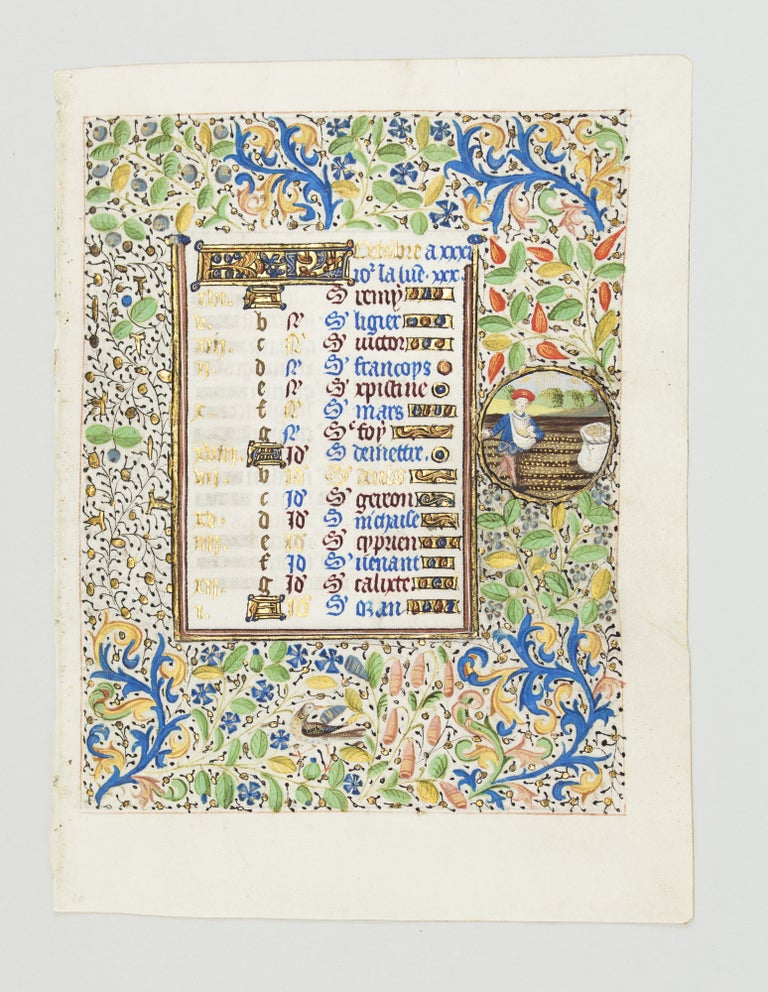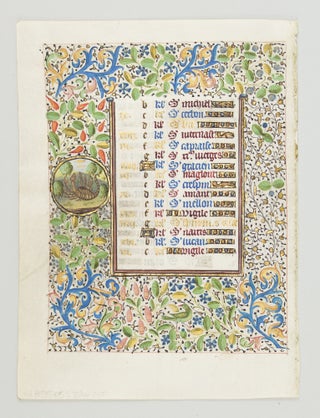TEXT FOR THE MONTH OF OCTOBER.
(Paris, ca. 1460). 195 x 143 mm. (7 3/4 x 5 1/2"). Single column, 16 lines in a gothic book hand.
Minor feast days in red and blue, major feasts in gold, numerous gold and painted line fillers, the five "A" initials and the "KL" highly decorative and painted pink and blue against a gold background, gold and pink bar surrounding the text on three sides, BOTH SIDES OF THE LEAF WITH EXTRAVAGANTLY DECORATIVE BOTANICAL FULL BORDERS with two small birds hidden within, and INCORPORATING TWO MEDALLION MINIATURES DEPICTING THE LABOR OF THE MONTH (SOWING) AND THE SIGN OF THE ZODIAC (SCORPIO) FOR OCTOBER. ◆IN VERY FINE, FRESH CONDITION, with gold and paint extraordinarily bright.
The extraordinarily lavish and animated full borders, coupled here with extensive use of brushed and burnished gold--for major feast days, for decorative border elements, and even for the hundreds of seeds being sown(!)--suggests that this calendar folio comes from a Book of Hours that was commissioned for a person or persons of high rank, since it would have been very costly. The leaf comes from a manuscript that included numerous roundels depicting the lives of St. Catherine and the more obscure St. Alexius, and it is possible that the Book of Hours belonged to a husband and wife for whom these saints served as patrons. The style of the delicately painted figures, especially in the roundels, indicates an artist who was familiar with the early output of the Coëtivy Master, who, according to Avril and Renaud, can be identified with Colin d'Amiens, who made a great name for himself in Paris (not, as was previously thought, with Henri de Vulcop, who made a great name for himself in the Loire region). The master takes his name from the Book of Hours (now in the Austrian national library) that he painted for Olivier de Coëtivy and his wife, Marie de Valois, one of some 30 works that have been identified as his. Although there is considerable Flemish influence that can be seen in his work (he has links, for example, with Simon Marmion), Colin d'Amiens was active in Paris during the third quarter of the 15th century, and, with Barthélmy van Eyck and Jean Fouquet, was among the three great artists of this period patronized by the French court--Avril and Renaud says flatly that our master was "the most important artist practising in Paris in the third quarter of the century, from about 1450 to 1485." For more on the Coëtivy Master, see Avril and Reynaud, pp. 58-69. (ST12835)
Price: $6,500.00


